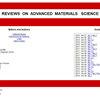Toward sustainability: Integrating experimental study and data-driven modeling for eco-friendly paver blocks containing plastic waste
IF 3.9
4区 材料科学
Q2 MATERIALS SCIENCE, MULTIDISCIPLINARY
引用次数: 0
Abstract
Plastic waste (PW) poses a significant threat as a hazardous material, while the production of cement raises environmental concerns. It is imperative to urgently address and reduce both PW and cement usage in concrete products. Recently, several experimental studies have been performed to incorporate PW into paver blocks (PBs) as a substitute for cement. However, the experimental testing is not enough to optimize the use of waste plastic in pavers due to resource and time limitations. This study proposes an innovative approach, integrating experimental testing with machine learning to optimize PW ratios in PBs efficiently. Initially, experimental investigations are performed to examine the compressive strength (CS) of plastic sand paver blocks (PSPBs). Varied mix proportions of plastic and sand with different sizes of sand are employed. Moreover, to enhance the CS and meet the minimum requirements of ASTM C902-15 for light traffic, basalt fibers, a sustainable industrial material, are also utilized in the manufacturing process of environmentally friendly PSPB. The highest CS of 17.26 MPa is achieved by using the finest-size sand particles with a plastic-to-sand ratio of 30:70. Additionally, the inclusion of 0.5% basalt fiber, measuring 4 mm in length, yields further enhancement in outcome by significantly improving CS by 25.4% (21.65 MPa). Following that, an extensive experimental record is established, and multi-expression programming (MEP) is used to forecast the CS of PSPB. The model’s projected results are confirmed by using various statistical procedures and external validation methods. Furthermore, comprehensive parametric and sensitivity studies are conducted to assess the effectiveness of the MEP-based proposed models. The sensitivity analysis demonstrates that the size of the sand particles and the fiber content are the primary factors contributing to more than 50% of the CS in PSPB. The parametric analysis confirmed the model’s accuracy by demonstrating a comparable pattern to the experimental results. Furthermore, the results indicate that the proposed MEP-based formulation exhibits high precision with an实现可持续发展:将实验研究与数据驱动模型相结合,制作含塑料废料的环保型铺路砖
塑料废弃物(PW)作为一种危险材料构成了重大威胁,而水泥的生产又引发了环境问题。当务之急是解决并减少混凝土产品中的废料和水泥用量。最近,已经开展了几项实验研究,在摊铺机砌块(PBs)中掺入废旧塑料作为水泥的替代品。然而,由于资源和时间的限制,实验测试不足以优化废塑料在摊铺机中的使用。本研究提出了一种创新方法,将实验测试与机器学习相结合,以有效优化 PB 中的废塑料配比。首先,对塑料砂摊铺砌块(PSPB)的抗压强度(CS)进行了实验研究。实验中采用了不同比例的塑料和砂以及不同规格的砂。此外,为了提高 CS 并满足 ASTM C902-15 对轻型交通的最低要求,还在环保型 PSPB 的制造过程中使用了玄武岩纤维(一种可持续发展的工业材料)。使用细砂颗粒,塑料与砂的比例为 30:70,可获得 17.26 兆帕的最高 CS 值。此外,加入 0.5% 的玄武岩纤维(长度为 4 毫米)可进一步提高效果,将 CS 显著提高 25.4% (21.65 兆帕)。随后,建立了广泛的实验记录,并使用多重表达式编程(MEP)来预测 PSPB 的 CS。该模型的预测结果通过各种统计程序和外部验证方法得到了确认。此外,还进行了全面的参数和敏感性研究,以评估基于多表达式编程的拟议模型的有效性。敏感性分析表明,砂粒的大小和纤维含量是导致 PSPB 中超过 50% 的 CS 的主要因素。参数分析证实了模型的准确性,其模式与实验结果相当。此外,研究结果表明,所提出的基于 MEP 的配方具有较高的精度(R 2 为 0.89)和较强的预测能力。该研究还提供了一个图形用户界面,以提高 ML 在处理废物管理实际应用中的重要性。本研究的主要目的是通过机器学习与实验研究的结合,提高废水的再利用率,以促进可持续发展和经济效益,特别是在创造绿色环境方面。
本文章由计算机程序翻译,如有差异,请以英文原文为准。
求助全文
约1分钟内获得全文
求助全文
来源期刊

Reviews on Advanced Materials Science
工程技术-材料科学:综合
CiteScore
5.10
自引率
11.10%
发文量
43
审稿时长
3.5 months
期刊介绍:
Reviews on Advanced Materials Science is a fully peer-reviewed, open access, electronic journal that publishes significant, original and relevant works in the area of theoretical and experimental studies of advanced materials. The journal provides the readers with free, instant, and permanent access to all content worldwide; and the authors with extensive promotion of published articles, long-time preservation, language-correction services, no space constraints and immediate publication.
Reviews on Advanced Materials Science is listed inter alia by Clarivate Analytics (formerly Thomson Reuters) - Current Contents/Physical, Chemical, and Earth Sciences (CC/PC&ES), JCR and SCIE. Our standard policy requires each paper to be reviewed by at least two Referees and the peer-review process is single-blind.
 求助内容:
求助内容: 应助结果提醒方式:
应助结果提醒方式:


